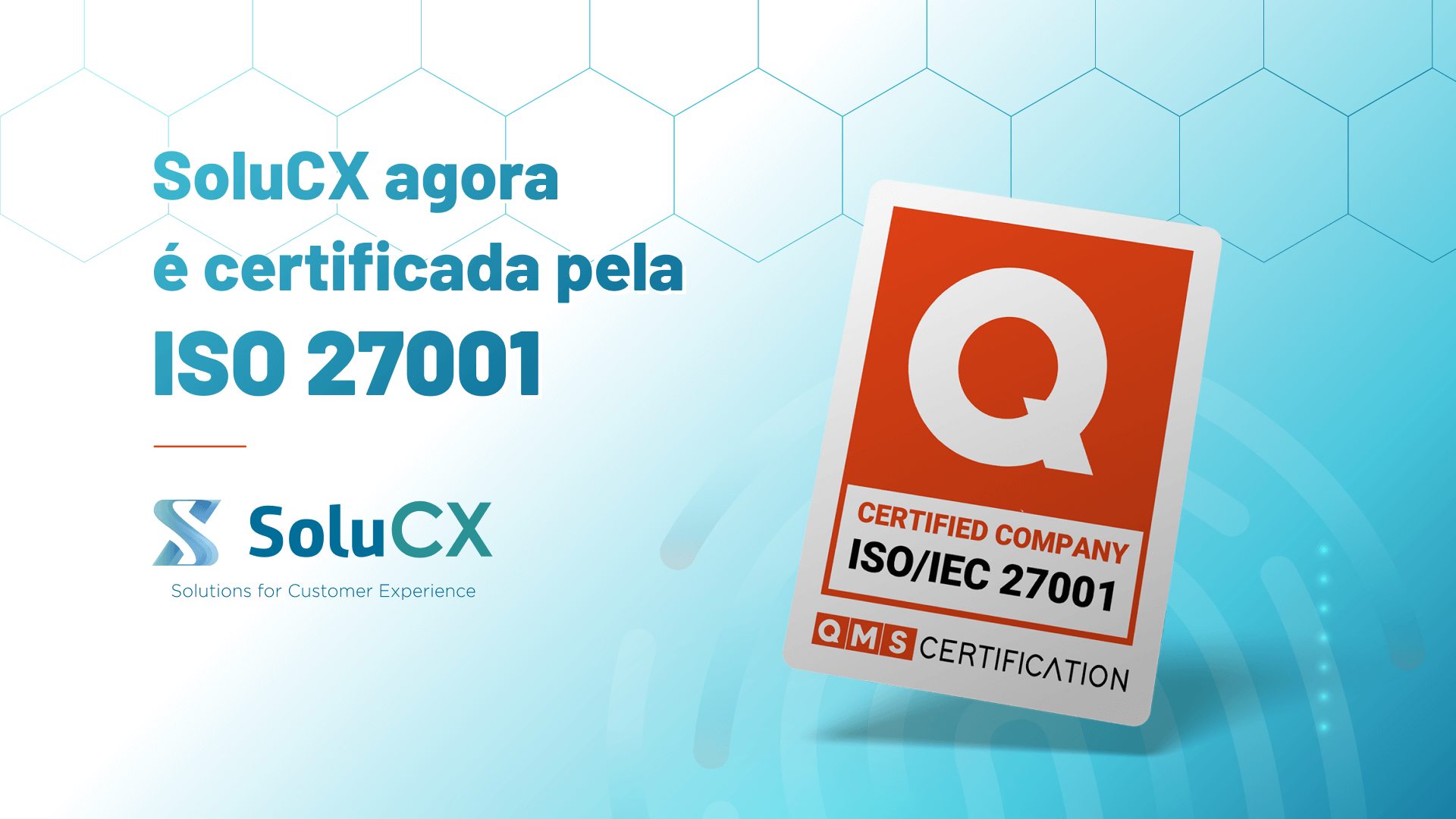In this material, we have gathered some publications on the Net Promoter Score (NPS) method of some health institutions, divided into: Diagnostic Medicine, Hospitals and Health Plans. Happy reading!
Written by Alan Reis and Paulo Veloso
Presentation
Is my NPS good? To answer this question, you must first understand the context of the segment in which your institution operates and, thus, compare the indicator with your main competitors. For example: If you represent a hospital, it will not make any sense to equate your result with a drugstore.
The NPS method is applied in several corporations and segments. It was created by Frederick F. Reichheld, featured in a publication in the Harvard Business Review in 2003, evolved into a book edition in 2006 and updated five years later. Despite its applicability, many health institutions do not use this methodology to understand the degree of satisfaction and loyalty of their patients, categorizing them as promoters, neutrals or detractors as the method suggests. Thus, there is a certain difficulty in finding reliable and up-to-date results on the NPS of this segment.
We decided to write this material in order to unify the results of recent years regarding the main publications of health associations and companies. The second section consists of an approach to diagnostic medicine, section three reveals data from hospitals, in section four, we demonstrate an analysis by health plan operators and, finally, we present a conclusion.
The information in this material was extracted from the institutions that incorporate the NPS data in the sustainability report or financial statements. We do not know the channels and techniques used during the collection of opinions, so these procedures can impact on “improvement” or “worsening” of the results when compared.
Diagnostic Medicine
Since 2018, the Brazilian Association of Diagnostic Medicine (ABRAMED) has been disclosing the results of its members, including: Dasa, Grupo Fleury, Alliar, Hermes Pardini and Sabin. The publication of the DNA of the diagnosis annually presents the main data of the sector, including the level of patient satisfaction. The associated companies until 2018 accounted for an average result of 75.1% in 2015; compared to 2017, there was a growth of 3.2% in the NPS score. The new members incorporated the balance and made the percentage rise to 80.9% in 2017, increasing 2% in the result extracted in 2018 (Figure 1).
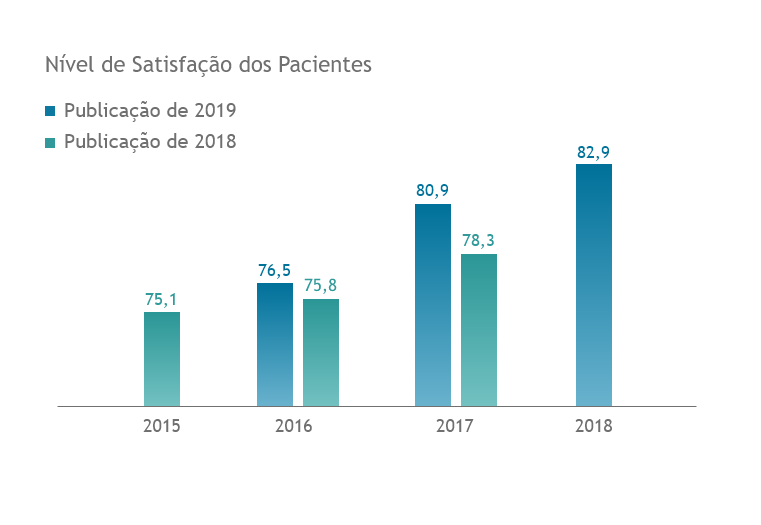
The calculation of the NPS is very simple: It is based on the balance of promoting patients subtracting the detractors, using a definitive and sentimental question, with a scale from 0 to 10, asking “how much would you recommend the COMPANY to a friend or family member?”. Patients who score a score from 0 to 6 are considered detractors, 7 and 8 are neutral, and 9 or 10 are promoters. It is worth mentioning that the result can vary from -100 to +100.
Since it began measuring the NPS of its brands, Alliar has achieved growth of 2.5% in the first quarter of 2019. The company’s best result was obtained in the third period of 2018, reaching 68.6%. Even so, Alliar failed to reach the seven dozen mark in the 90-day compiled result. Grupo Fleury began disclosing the NPS associated with financial results in the first quarter of 2015, in which it reached more than 70 points from the second interval of that date. Hermes Pardini, on the other hand, rounds its indicator, a practice that is not recommended, and preserves a result close to the Fleury Group. Finally, Sabin has the best result in this comparison, compared to the four brands. It is worth noting that the data refer to the patient’s communication channels with the brand extracted in a period of one year (Figure 2).
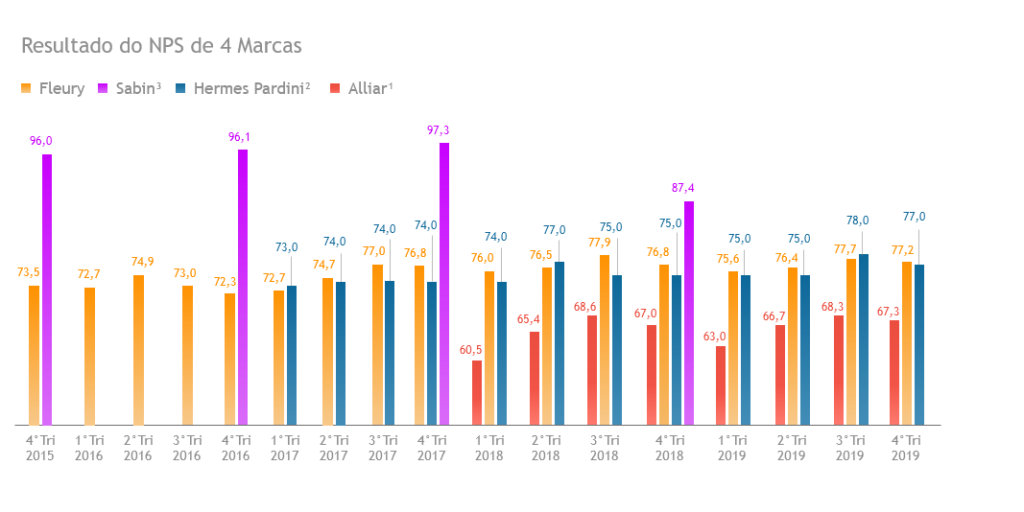
¹Completed in Q1Q18 the process of capturing information regarding patient satisfaction.
²The results of the 4th Q19 and 3rd Q19 are from the CMNG brand as they have not been globally released.
³Monitors this indicator in the service channels, disclosing the result annually.
Hospitals
The company Bain & Company, in partnership with the National Association of Private Hospitals (ANAHP), conducted a satisfaction survey with approximately 14,000 patients in 18 Brazilian private hospitals. The study considered institutions that had more than 200 valid evaluations and at least 50 responses per type of service. Overall, the average NPS was 59%, revealing a discrepancy of 63 percentage points, with a maximum of 87% and a minimum of 24% among the hospitals analyzed. The sector with the lowest average score was the emergency room, with 23%, a maximum of 78% and a minimum of -14% (Figure 3). According to the study, the two private hospitals with the best indicators in Inpatient and Outpatient Clinics presented, respectively, the SPL of 41% and 50% in the emergency room.
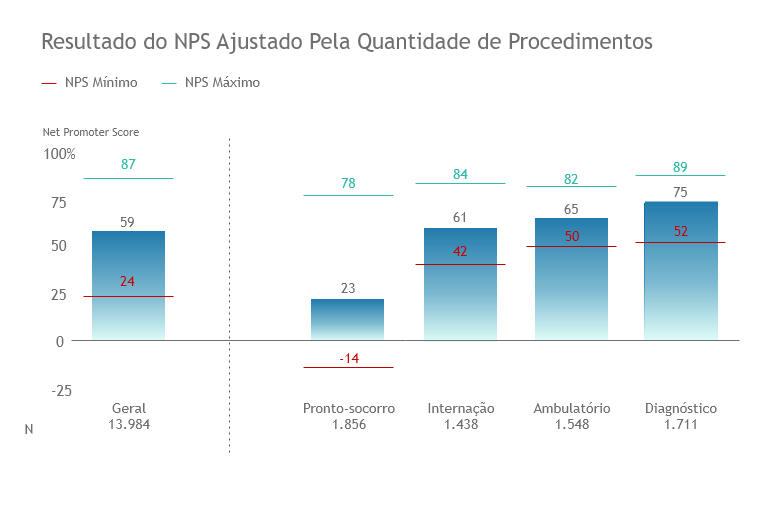
At Hospital Israelita Albert Einstein, the Diagnostic Medicine sector leads the NPS score with 86.10%, approaching the result obtained by Sabin in Figure 2. The lowest score reached was related to emergency care, 66.10%. A relevant fact is in the disclosure of the sectoral NPS, a more detailed view of its results, leaving only the disclosure of the global NPS. The Syrian-Lebanese Hospital decreased 1.89% compared to 2017, a fact that led it to be in second place, behind the A. C. Camargo Cancer Center, with a difference of 0.98%. The São Francisco Xavier Foundation, the Moinhos de Vento Hospital and the Beneficência Portuguesa de São Paulo round up their indicator and have a percentage of 82, 80 and 76%, respectively. The Oswaldo Cruz German Hospital has 73.50% and, in the last position, among these institutions (Figure 4).
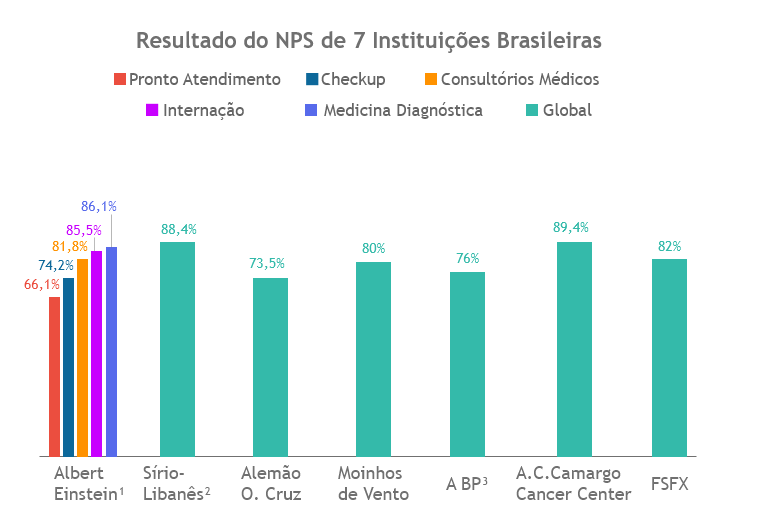
¹In 2018, Albert Einstein started to conduct the NPS survey, disclosing the results by sector.
²The Syrian-Lebanese had a rate of 90.31% in 2017.
³BP started measuring NPS in 2017 and reached 73%.
Health plan operators
Few operators disclose their results and most still do not use NPS as a system to understand the degree of satisfaction and loyalty of their beneficiaries. Health plans carry out a maximum of two surveys per year, mainly to meet the requirements of the National Supplementary Health Agency (ANS) regarding the Supplementary Health Performance Index (IDSS) survey. Unlike this principle, Amil publishes its results by product line, in which “Premium” has the highest score with 52 points against 19 points for the “Community” line. Unimed Porto Alegre and Belo Horizonte show the overall result, with 71.48% and 59%, respectively (Figure 5).
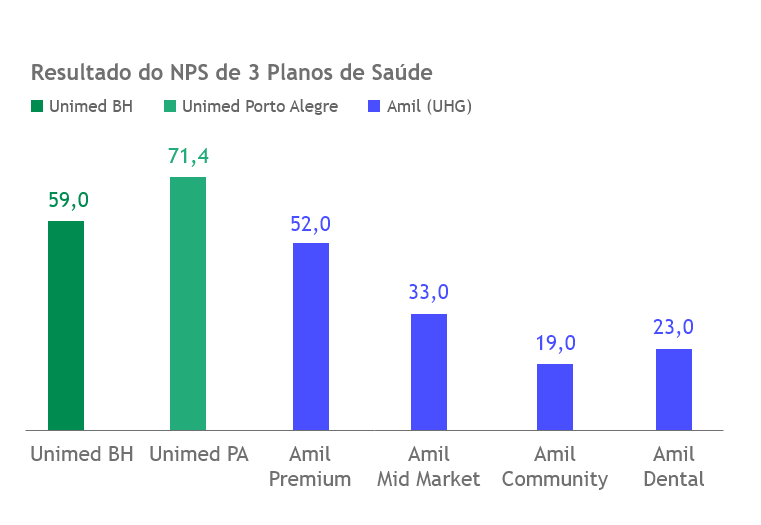
The lessons we can learn from this content
Comparing your NPS with the market is essential. Without this, it will not be possible to understand if your indicators are satisfactory or even to establish an action plan focused on improvement. Avoiding confronting your NPS with companies or institutions from different segments is essential. Each branch of activity has its particularities, processes, activities, experiences and behaviors of consumers or patients with completely different profiles. Thus, it is necessary to always look for references from companies that have the same business model, operate in the same market and apply the same measurement standard.
The health segment, although evolved in the subject of satisfaction surveys, still lacks institutions and companies that use NPS as a system (S – System) to improve their internal processes based on the feedback loop of patients or beneficiaries. One of the challenges in producing this material was to find NPS data from the most referenced institutions in the country. Some do not apply this methodology and others do not disclose their results publicly. In this sense, we believe that the evolution of the market also involves an awareness and dissemination of the importance of using methods that help institutions to make daily decisions to improve their operational and managerial processes, using a simpler questionnaire and abandoning long and outdated surveys.
About SoluCX
SoluCX is a startup from São José dos Campos/SP, specialized in omnichannel satisfaction surveys, which, among the main methodologies in the market, uses NPS, CSAT and CES. Our startup presents companies with the importance of using these methodologies on a daily basis, as well as their relationship with increased revenues and customer loyalty. Learn more!
References
THE BENEFICÊNCIA PORTUGUESA DE SÃO PAULO. Sustainability reporting.
ABRAMED – Brazilian Association of Diagnostic Medicine. The DNA of the 2018 diagnosis.
ABRAMED – Brazilian Association of Diagnostic Medicine. The DNA of diagnosis 2019 .
A.C. Camargo Cancer Center. Sustainability report.
SÃO FRANCISCO XAVIER FOUNDATION. Sustainability reporting.
HERMES PARDINI. Investor relations.
OSWALDO CRUZ GERMAN HOSPITAL. Sustainability reporting.
ALBERT EINSTEIN ISRAELI HOSPITAL. Sustainability reporting.
WINDMILLS HOSPITAL. Annual report 2018.
SYRIAN-LEBANESE HOSPITAL. Sustainability reporting.
REICHHELD, F. F. The one number you need to grow. Harvard Business Review, 2003.









